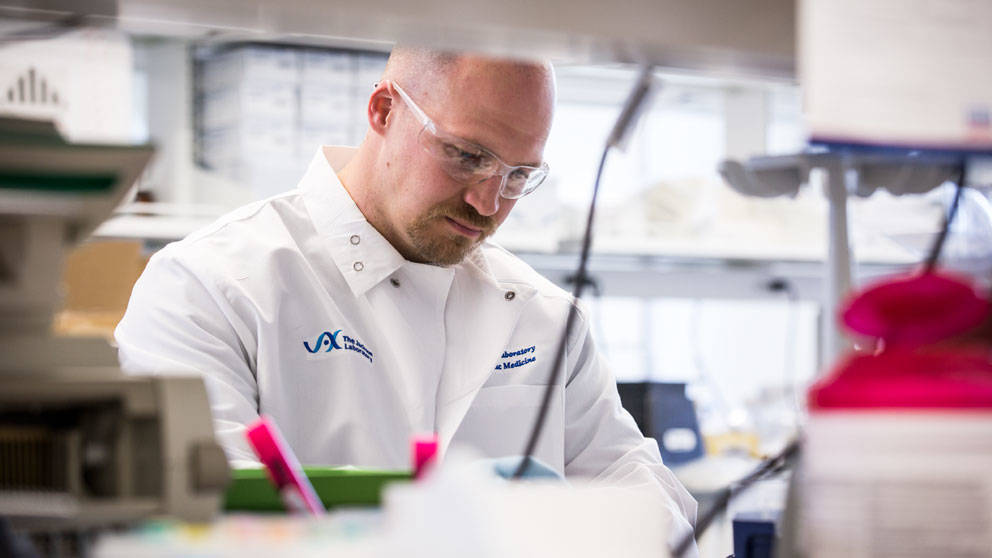
JAX Assistant Professor Adam Williams conducts research that bridges immunology, genomics research, and bioinformatics to develop a deeper understanding of asthma pathogenesis.
Nearly 235 million people worldwide have asthma, making it a public health problem of epidemic proportions.
According to the World Health Organization, asthma is the most common chronic disease in children and is particularly acute in low- and middle-income countries, where more than 80 percent of asthma deaths occur. There is no cure for the disease.
Armed with a $2.4 million grant from the National Institutes of Health, JAX Assistant Professor Adam Williams, Ph.D., is studying the role of molecules called long, non-coding RNAs (lncRNA; pronounced link RNA) in asthma. lncRNAs are transcribed from DNA like regular messenger RNA, but they don’t code for proteins. Their functions within cells were mostly unknown until recently, but their importance in normal function and disease has led to a rapid increase in research over the past decade. In previous studies, Williams and his team found particular lncRNAs, potentially associated with asthma, and they are now seeking to determine the mechanisms involved.
“This research could help human health on many levels,” says Williams. “It identifies lncRNAs as being important in asthma, with the ultimate goal of targeting lncRNAs with therapeutics in the future.”
Asthma is a chronic lung disease that inflames and narrows the airways, causing recurring periods of wheezing, chest tightness, shortness of breath, and coughing. Many people with asthma have an allergic response in their lungs that leads to the production of the IL-13 cytokine, a protein made by specific immune cells. IL-13 interacts with the airway epithelium, the cells in the lung that conduct air to and from the alveoli, the tiny sacs that allow oxygen and carbon dioxide to move between the lungs and the bloodstream. This interaction leads to the secretion of excessive amounts of mucus and altered lung function.
Williams’ study aims to determine the mechanism by which lncRNAs control the response of airway epithelial cells to IL-13. His work will identify what lncRNAs are doing, how they are doing it, and whether they can be targeted with therapeutics to modify lung function. “The end goal,” he says, “is to restore some of this altered lung function in people with asthma.”
Williams is one of only a few scientists studying lncRNAs to understand their role in immune cell development, differentiation, and function in asthma. This work will enable him and his colleagues to define asthma subtypes, identify mechanisms driving asthma susceptibility, and reveal novel therapeutic targets.
Unlike their protein-coding brethren, lncRNAs have a unique characteristic: they are generally tissue-specific. This specificity makes them particularly exciting targets because specific lncRNAs may be linked to particular cell types or disease states. While there are currently no anti-lncRNA drugs on the market, the US Food and Drug Administration approved the first RNA-based therapy in January 2019 to treat a rare genetic disease, opening the way for the development of therapies that target lncRNAs.
Through his previous research, Williams has identified lncRNAs highly induced by IL-13, some of which potentially regulate critical cell signaling pathways in the lung that are altered in asthma. With his grant, he will grow human airway epithelial cells in three-dimensional organoid cultures, research models that recapitulate much of the actual makeup of the cells, to determine which cell types rev up the lncRNA expression when exposed to IL-13.
“The important feature of these ‘lungs in a dish.’” says Williams, “is that they develop cilia [tiny hair-like structures that help to keep the airways clear of mucus] and they make mucus, so they function much more like epithelial cells really do in the lungs.”
Single-cell RNA sequencing studies of the organoid cultures, which enable researchers to isolate individual cells to determine their molecular make-up and how they function, will allow Williams and his colleagues to identify which cell types upregulate lncRNAs following IL-13 exposure. Additional mechanistic experiments will help to reveal other aspects of the lncRNA function and determine which proteins they bind to and what genes they regulate.